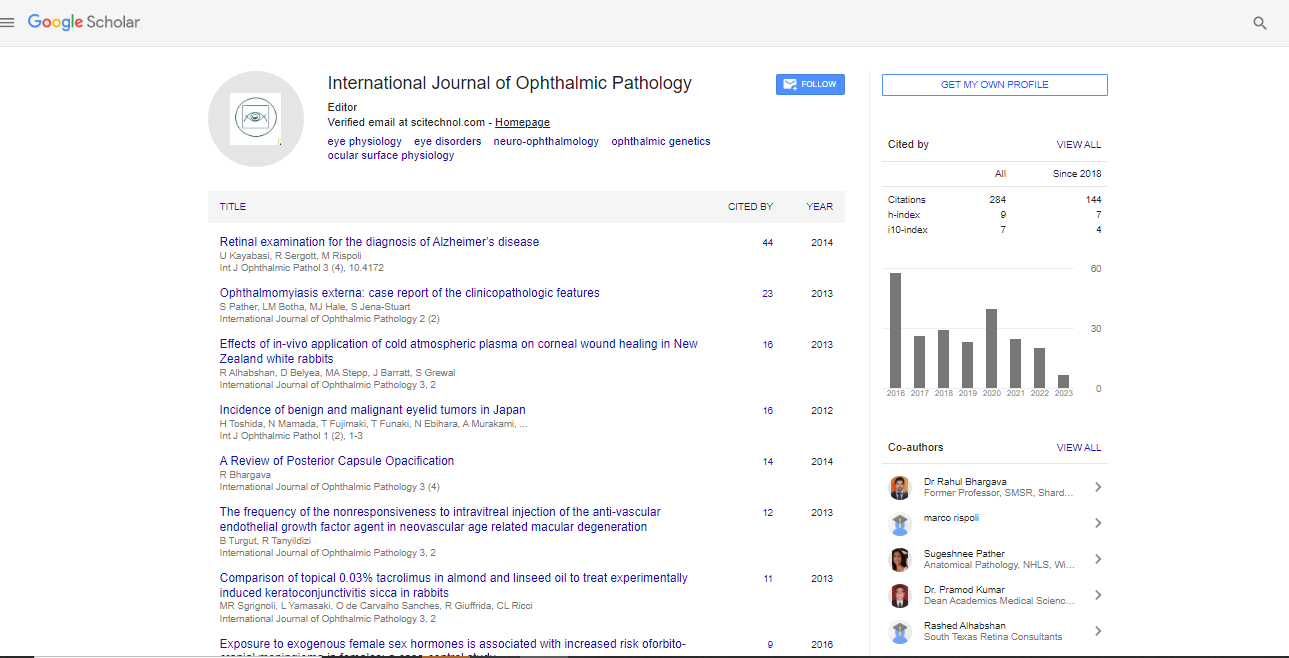Photorefractive ablation of the cornea with cross-linking effect
Igor Kornilovskiy
Pirogov National Medical-Surgical Center, Russia
: Int J Ophthalmic Pathol
Abstract
Purpose: To evaluate the effect of a cross-linking under photorefractive ablation of the cornea saturated with riboflavin Methods: Several studies on corneal collagen cross-linking (CXL) and secondary radiation induced by excimer laser ablation were reviewed. TransPRK, LASIK and FemtoLASIK were performed on 402 eyes with myopia and myopic astigmatism. Photorefractive ablation was performed after corneal stroma saturation with 0.25% isotonic riboflavin. Follow-up varied from 1 month to 4 years. The effects of CXL were assessed by spectral-domain OCT and corneal densitometry Results: CXL induced by photorefractive ablation with riboflavin is realized through the series of consecutive reactions of riboflavin activation. Activation of riboflavin with the secondary radiation induced by corneal ablation is considered as a trigger. Broad spectrum of the secondary radiation covers all four peaks of maximum riboflavin absorption at 223, 268, 374, and 445 nm. Cross-linking effect amplifies due to the secondary interaction of riboflavin with peroxyl radicals of the oxidative stress and aseptic inflammation in the stroma in response to photorefractive keratectomy. Corneal densitometry and anterior segment OCT demonstrate that CXL increases optical density of the residual stroma and enhances the absorption of external UV photons. This improves or compensates impaired mechanical and photo protective functions of the ablated cornea. Thin membrane-like Structure on the ablation surface as well as higher optical density of the corneal stroma adjacent to the ablation zone are revealed after TransPRK with riboflavin. In addition to the higher optical density of the corneal stroma, demarcation line of various intensity (which resolves later) is revealed after LASIK and FemtoLASIK. Conclusions: The effect of crosslinking in photorefractive ablation with riboflavin was realized through the formation of a membrane-like structure on the ablation surface and was accompanied by an increase in the optical density in the layers of the stroma adjacent to the ablation zone Key words: cross-linking, secondary excimer laser radiation, photorefractive ablation, riboflavin.
Biography
Igor Kornilovskiy is professor of the Department of Ophthalmology of Institute of Postgraduate Medical Education; consultant and laser refractive surgery of the Center of Ophthalmology of Pirogov National Medical-Surgical Center; Doctor of Medical Sciences, Professor, Academician of the Laser Academy of Sciences of Russia.In1974, Dr I.M. Kornilovsky had graduated from the Faculty of Medicine of Krasnoyarsk State Medical University, then, completed the one-year internship training in ophthalmology at the same university. While working as a healthcare practitioner specializing as an ophthalmologist, in 1979 he had defended the M.D. thesis on the topic: “Experimental and clinical development of the test and method to evaluate the functional state of blood vessels in the eye”, and was awarded the M.D. degree. In 1981, Dr I.M. Kornilovsky had moved to Moscow where he worked for many years at the Federal IRTC “Eye Microsurgery” complex named after S.N. Fedorov. In1995, while working at the IRTC, he had defended the doctorate thesis on the topic: “Eximer-laser for treating corneal pathology” and was awarded the degree of doctor of medical sciences. In 1997 Dr I.M. Kornilovsky was elected the acting member (academician) of the Russian laser academy of sciences. The scientific interests of Professor Igor Kornilovskiy cover a wide range of research related to new technologies of laser refractive surgery of the cornea with photo protection and cross-linking; refractogenesis; accommodation; etiology and pathogenesis of myopia; aberrations of the eye optical system; restorative correction of vision based on spectacle, contact, laser and surgical correction; laser therapeutic and optic-reconstructive surgery on different pathology of the cornea. Igor Kornilovskiy is the author of 350 scientific papers on different issues of ophthalmology, over 35 inventions, patents and innovation proposals.
E-mail: kornilovsky51@yandex.ru
 Spanish
Spanish  Chinese
Chinese  Russian
Russian  German
German  French
French  Japanese
Japanese  Portuguese
Portuguese  Hindi
Hindi 